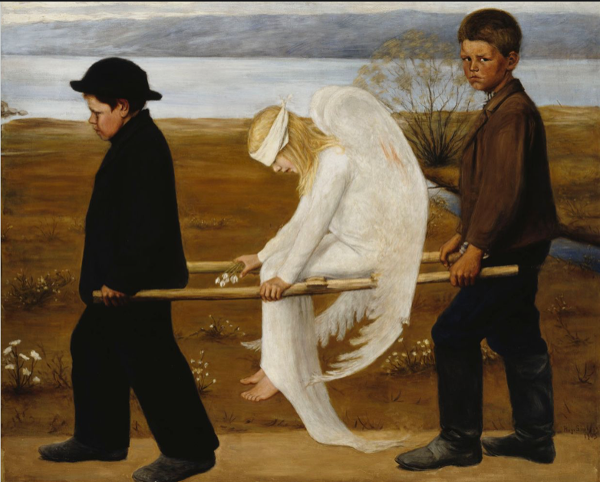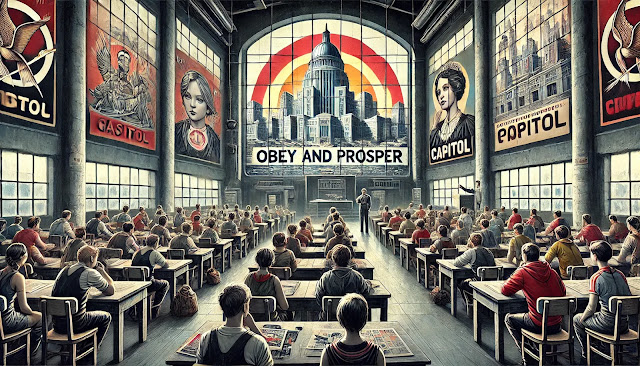After reading Helena Ruuska's biography of Hugo Simberg, I began to see Simberg's paintings in a new light. Many Finns recognize his painting of the wounded angel being carried on a stretcher by little boys. I have always liked the painting and thought it symbolizes the idea that no one is invulnerable (not even an angel), but we still have hope if we care for each other. If we can heal angels, we can do anything. In the painting, the boys are in adult clothes. There's a bloodstain on the angel's wing. The boy in front looks straight ahead, the angel girl looks down, and the boy at the back looks at the viewer.
Hugo Simberg (1873–1917) was a Finnish symbolist painter famous for his enigmatic yet deeply humanistic works that explore themes of mortality, mysticism, and nature. His art, characterized by a unique blend of realism and fantasy, holds a special place in the hearts of Finns, embodying a profound connection to the Finnish landscape and psyche.
Ruuska's book presented alternative interpretations. According to one, all the figures in the picture are self-portraits of Simberg. The boy at the front is the artist, who, despite criticism, keeps pushing forward. The angel on the stretcher represents Simberg as chronically ill, and the boy at the back represents Simberg as an ordinary Finnish boy. These interpretations describe the different roles of Hugo Simberg. He was often sick and died of syphilis, which he suffered for his entire adult life. Death did not appear to Simberg as a gentle reaper but as a cruel torturer. Hugo suffered from pain and the disease throughout his life, and death came as a seizure.
Another interpretation suggests that the angel on the stretcher is the Maiden of Finland, wounded by Russian oppression. Looking at the picture this way, one notices the boy at the back looking accusingly: "Look what you did, Russia." Another work, "Death Skates," has been interpreted as a symbol of the Russian Tsar's Russification efforts, which many artists took a stand against at the time. However, it needs to be determined whether it was a political statement, as Simberg usually didn't make such a statement. Although, he started writing his letters in Finnish "because the situation demands it now."
Helena Ruuska mentioned in her book that without Akseli Gallen-Kallela, Hugo Simberg might not be among the leading names in Finnish art. Trend-conscious Gallen wanted to try something new among the first and built a studio in the wilderness. Simberg occasionally joined him as a student, and they became good friends. Gallen-Kallela said he had a great student whose works were like sermons and memorable. Simberg's folk images vibrate with harsh everyday life and a tender smile. Hugo was an empathetic sympathizer. "The Wounded Angel" is considered a central work of Finnish symbolism in art history.
Hugo Simberg sketched "The Wounded Angel" for three years. At some point, devils were in place of the little boys. The work is both symbolic and realistic at the same time. The landscape where the procession wanders can be identified as Töölönlahti if one knows the background of the work; otherwise, it could be anywhere. In the harsh springland, delicate white flowers grow, the same flowers the angel holds in her hand. Spring, even a harsh one, is a time of hope.
Why do different people see different things in paintings?
Seeing is more complex than one might imagine. Our brains interpret what they see unconsciously and fill in the gaps. When looking at the same thing for different purposes, one sees and looks for different things. What you see depends on why you look. In a study by Mariëtte Van Maarseveen's group, football players were asked to watch game situations on video. Their eye movements were tracked. The study found that football players looked at entirely different things when asked to either anticipate what would happen next, think about what would be advisable to do in each situation or identify patterns in what they saw. When watching videos for different purposes, completely different things were seen. The same person can see different things on different occasions if they look for different reasons.
The motive for looking affects what we see, just one perplexing aspect of seeing. David Eagleman has studied visual illusions, mainly what happens in the brain. He talks about the cube test. When looking at a cube on paper, sometimes its front is noticeable. Sometimes, the front turns into the back. If you look long enough, it changes back again. Since nothing changes on the paper, the change occurs only in the brain. Eagleman says in his book "Incognito," that seeing is an active action, not a passive reception. According to David Eagleman, the brain completes what we do not see. In other words, we do not see what is in front of us but our brain's interpretation of it. The brain complements our sensory perceptions to make them understandable. Seeing, therefore, is interpreting clues and synthesizing them. What is perplexing is that we are not aware of how our brains interpret what we see. We cannot access the automatic machinery by which our brains deduce these things. Therefore, our reason for looking at something and what we try to see in it affects our seeing. In addition, seeing is active interpretation and reasoning. In other words, seeing is a social construction.
Each viewer interprets "The Wounded Angel" in their way, as the artist might have hoped by drawing a line next to the name. Art challenges us to see the world with new eyes. Interpreting art reflects both the individual's experiences and the context of society. The power of art lies in its ability to awaken in us a desire to understand each other and the world better, offering comfort that we are not alone in our experiences.
References
Ruuska, Helena (2018): Hugo Simberg: Pirut ja enkelit, WSOY.
Van Maarseveen, Mariëtte & Oudejans, Raôul & Mann, D.L. & Savelsbergh, G.J.P (2016): “Perceptual-cognitive skill and the in situ performance of soccer players”, Quarterly Journal of Experimental Pscyhology
Eagleman, David (2013): ” Incognito – The secret lives of a brain”, Robert Laffont, s. 20-55



Comments
Post a Comment